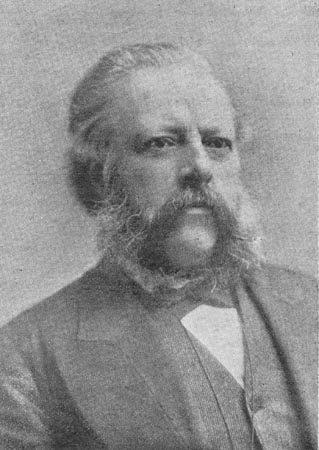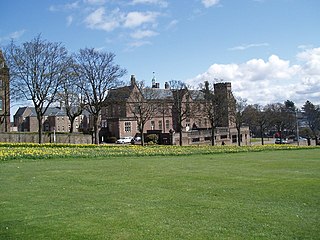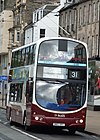
Dr Joseph Sampson Gamgee, MRCS, FRSE was a surgeon at the Queen's Hospital in Birmingham, England. He pioneered aseptic surgery, and, in 1880 invented Gamgee Tissue, an absorbent cotton wool and gauze surgical dressing.

James Syme was a pioneering Scottish surgeon.

The Royal College of Surgeons of Edinburgh (RCSEd) is a professional organisation of surgeons. The College has seven active faculties, covering a broad spectrum of surgical, dental, and other medical practices. Its main campus is located on Nicolson Street, Edinburgh, within the Surgeons' Hall, designed by William Henry Playfair, and adjoining buildings. The main campus includes a skills laboratory, the Surgeons' Hall Museums, a medical and surgical library, and a hotel. A second office was opened in Birmingham (UK) in 2014 and an international office opened in Kuala Lumpur, Malaysia, in 2018.

The Royal Infirmary of Edinburgh (RIE), often known as the Edinburgh Royal Infirmary (ERI), was established in 1729 and is the oldest voluntary hospital in Scotland. The new buildings of 1879 were claimed to be the largest voluntary hospital in the United Kingdom, and later on, the Empire. The hospital moved to a new 900 bed site in 2003 in Little France. It is the site of clinical medicine teaching as well as a teaching hospital for the University of Edinburgh Medical School. In 1960, the first successful kidney transplant performed in the UK was at this hospital. In 1964, the world's first coronary care unit was established at the hospital. It is the only site for liver, pancreas and pancreatic islet cell transplantation and one of two sites for kidney transplantation in Scotland. In 2012, the Emergency Department had 113,000 patient attendances, the highest number in Scotland. It is managed by NHS Lothian.

The Meath Hospital was a general hospital in the Earl of Meath's Liberty in Dublin, Ireland. It was absorbed into the Tallaght Hospital in June 1998.
The University of Edinburgh Medical School is the medical school of the University of Edinburgh in Scotland and the United Kingdom and part of the College of Medicine and Veterinary Medicine. It was established in 1726, during the Scottish Enlightenment, making it the oldest medical school in the United Kingdom and is one of the oldest medical schools in the English-speaking world.
Allan Burns was a Scottish surgeon and physician. A lecturer on surgery and anatomy at Glasgow, he studied medicine in Glasgow. He visited Russia in 1804 and he published anatomical treatises. He was the son of Revd Dr John Burns, a minister of the Barony Church, and Elizabeth Stevenson. Of his brothers, Dr John Burns (1775–1850) became Regius Professor of Surgery at the University of Glasgow; James was a shipowner and George was his partner in G & J Burns.

Dundee Royal Infirmary, often shortened to DRI, was a major teaching hospital in Dundee, Scotland. Until the opening of Ninewells Hospital in 1974, Dundee Royal Infirmary was Dundee's main hospital. It was closed in 1998, after 200 years of operation.

Charles Frederick William Illingworth was a British surgeon who specialised in gastroenterology. Along with a range of teaching and research interests, he wrote several surgical textbooks, and played a leading role in university and medical administration.

Sir Harold Jalland Stiles was an English surgeon who was known for his research into cancer and tuberculosis and for treatment of nerve injuries.

Douglas James Guthrie FRSE FRCS FRCP FRCSEd FRCPE was a Scottish medical doctor, otolaryngologist and historian of medicine.
Saumitra Rawat is an Indian surgical gastroenterologist and the head of Surgical Gastroenterology and Liver Transplant at Sir Ganga Ram Hospital, New Delhi. The Government of India honoured him in 2015 with the award of Padma Shri.
John Gibson Fleming FRSE PFPSG (1809-1879) was a Scottish surgeon, medical administrator and President of the Royal College of Physicians and Surgeons of Glasgow 1865 to 1868, and 1870 to 1872.

Diarmid Noël Paton,, known as Noël Paton, was a Scottish physician and academic. From 1906 to 1928, he was the Regius Professor of Physiology at the University of Glasgow.
John Gamgee (1831–1894) was a British veterinarian and inventor. He specialised in the contagious diseases of larger animals: primarily cattle and horses.

Charles Walker Cathcart, CBE, MB CM, FRCSEd, FRCSE was a Scottish surgeon who worked for most of his career at the Royal Infirmary of Edinburgh (RIE). As a young man he had represented Scotland at rugby on three occasions. During the First World War he jointly published an account of the value of sphagnum moss as a wound dressing which led to its widespread use by the British Army for that purpose.

William James Stuart CBE PRCSE FRSE (1873-1958) was a 20th-century Scottish surgeon who served as President of the Royal College of Surgeons of Edinburgh from 1937 to 1939. He was affectionately known as Pussy Stuart.

Thomas Kennedy Dalziel, known as T Kennedy Dalziel, was a Scottish surgeon and pathologist who specialised particularly in abdominal surgery. Dalziel was most notable for being considered the best technical surgeon at the time in western Scotland. He was also particularly notable for the discovery of a disease called chronic interstitial enteritis in 1913, that later became known as Crohn's disease.
Extramural medical education in Edinburgh began over 200 years before the university medical faculty was founded in 1726 and extramural teaching continued thereafter for a further 200 years. Extramural is academic education which is conducted outside a university. In the early 16th century it was under the auspices of the Incorporation of Surgeons of Edinburgh (RCSEd) and continued after the Faculty of Medicine was established by the University of Edinburgh in 1726. Throughout the late 18th and 19th centuries the demand for extramural medical teaching increased as Edinburgh's reputation as a centre for medical education grew. Instruction was carried out by individual teachers, by groups of teachers and, by the end of the 19th century, by private medical schools in the city. Together these comprised the Edinburgh Extramural School of Medicine. From 1896 many of the schools were incorporated into the Medical School of the Royal Colleges of Edinburgh under the aegis of the RCSEd and the Royal College of Physicians of Edinburgh (RCPE) and based at Surgeons' Hall. Extramural undergraduate medical education in Edinburgh stopped in 1948 with the closure of the Royal Colleges' Medical School following the Goodenough Report which recommended that all undergraduate medical education in the UK should be carried out by universities.
Thomas Drummond Lambert was an English veterinary surgeon.

















